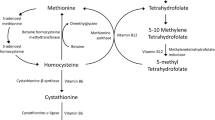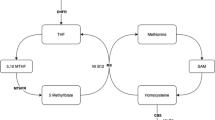Opinion statement
Observational data from prospective and retrospective studies indicate that elevated homocyst(e)ine (Hcy) is associated with preclinical markers of cerebrovascular disease and ischemic stroke.
Although the exact mechanisms of this association are unresolved, data indicate that elevated Hcy promotes cerebral, arterial, and venous thrombosis, and may predispose to premature atherosclerosis and craniocervical arterial dissection. Plasma Hcy is a sensitive marker of low folate, B12, and B6 status. Data consistently indicate that folic acid supplementation in the form of vitamin tablets is the most effective strategy to lower mild-to-moderately elevated Hcy, with maximal benefit occurring in individuals with higher pretreatment Hcy or lower pretreatment folate levels. B12 supplementation confers a minor additional benefit, whereas B6 supplementation has not been demonstrated to confer further benefit. Despite reports that Hcy-lowering therapy may improve surrogate measures of vascular disease, the outcomes of clinical trials for secondary stroke prevention are pending. Until this information is available, we concur with the American Stroke Association guidelines for stroke prevention. Specifically, we recommend good dietary intake of foods rich in folic acid, B6, and B12 for primary prevention, and supplemental multivitamins (folic acid 400 μg to 1 mg daily, B12 400 to 600 μg daily, B6 2 to 10 mg daily) for individuals with known cerebrovascular disease and hyper-Hcy.
Similar content being viewed by others
References and Recommended Reading
McCully K: Vascular pathology of homocysteinemia: implications for the pathogenesis of atherosclerosis. Am J Pathol 1969, 56:111–128.
Welch G, Loscalzo J: Mechanisms of disease: homocysteine and atherothrombosis. N Engl J Med 1998, 338:1042–1050.
Mudd SH, Finkelstein JD, Refsum H, et al.: Homocysteine and its disulfide derivatives: a suggested consensus terminology. Arterioscler Thromb Vasc Biol 2000, 20:1704–1706.
Selhub J, Jacques PF, Wilson PWF, et al.: Vitamin status and intake as primary determinants of homocysteinemia in an elderly population. JAMA 1993, 270:2693–2698.
Rozen R: Genetic modulation of homocysteinemia. Semin Thromb Hemost 2000, 26:255–261.
Tawakol A, Omland T, Gerhard M, et al.: Hyperhomocyst(e)inemia is associated with impaired endothelium-dependent vasodilation in humans. Circulation 1997, 95:1119–1121.
Malinow M, Nieto F, Szklo M, et al.: Carotid artery intimal-medial wall thickening and plasma homocyst(e)ine in asymptomatic adults. The Atherosclerosis Risk in Communities Study. Circulation 1993, 87:1107–1113.
Selhub J, Jacques PF, Bostom AG, et al.: Association between plasma homocysteine concentrations and extracranial carotid-artery stenosis. N Engl J Med 1995, 332:286–291.
Eikelboom JW, Hankey GJ, Anand SS, et al.: Association between high homocyst(e)ine and ischemic stroke due to large- and small-artery disease but not other etiologic subtypes of ischemic stroke. Stroke 2000, 31:1069–1075.
Delport R, Ubbink JB, Vermaak WJH, et al.: Hyperhomocysteinemia in black patients with cerebral thrombosis. Q J Med 1997, 90:635–639.
Evers S, Koch HG, Grotemeyer KH, et al.: Features, symptoms, and neurophysiological findings in stroke associated with hyperhomocysteinemia. Arch Neurol 1997, 54:1276–1282.
Bots ML, Launer LJ, Lindemans J, et al.: Homocysteine and short-term risk of myocardial infarction and stroke in the elderly: the Rotterdam Study. Arch Intern Med 1999, 159:38–44.
Coull BM, Malinow MR, Beamer N, et al.: Elevated plasma homocyst(e)ine concentration as a possible independent risk factor for stroke. Stroke 1990, 21:572–576.
Davi G, Di Minno G, Coppola A, et al.: Oxidative stress and platelet activation in homozygous homocystinuria. Circulation 2001, 104:1124–1128. Provides important in vivo data indicating that markers of oxidative stress and platelet activation are elevated in homocystinuric individuals compared with controls.
D’Angelo A, Selhub J: Homocysteine and thrombotic disease. Blood 1997, 90:1–11.
Cochran FB, Packman S: Homocystinuria presenting as sagittal sinus thrombosis. Eur Neurol 1992, 32:1–3.
Gallai V, Caso V, Paciaroni M, et al.: Mild hyperhomocyst(e)inemia: a possible risk factor for cervical artery dissection. Stroke 2002, 32:714–718.
Pezzini A, Del Zotto E, Archetti S, et al.: Plasma homocysteine concentration, C677T MTHFR genotype, and 844ins68bp CBS genotype in young adults with spontaneous cervical artery dissection and atherothrombotic stroke. Stroke 2002, 33:664–669. This paper, and the preceding paper by Gallai et al., provides important preliminary data indicating that mild-to-moderately elevated homocysteine is associated with spontaneous cervical artery dissection.
Spence JD, Malinow MR, Barnett PA, et al.: Plasma homocyst(e)ine concentration, but not MTHFR genotype, is associated with variation in carotid plaque area. Stroke 1999, 30:969–973.
Kelly PJ, Rosand J, Kistler J, et al.: Homocysteine, MTHFR 677C>T polymorphism, and risk of ischemic stroke. Result of a meta-analysis. Neurology 2002, in press. A comprehensive quantitative summary of the risk of ischemic stroke associated with elevated homocyst(e)ine and the MTHFR 677C>T polymorphism.
Perry IJ, Refsum H, Morris RW, et al.: Prospective study of serum total homocysteine concentration and risk of stroke in middle-aged British men. Lancet 1995, 346:1395–1398.
Verhoef P, Hennekens CH, Malinow MR, et al.: A prospective study of plasma homocyst(e)ine and risk of ischemic stroke. Stroke 1994, 25:1924–1930.
Fallon UB, Elwood P, Ben-Shlomo Y, et al.: Homocysteine and ischaemic stroke in men: the Caerphilly study. J Epidemiol Community Health 2001, 55:91–96.
Stehouwer CD, Weijenberg MP, van den Berg M, et al.: Serum homocysteine and risk of coronary heart disease and cerebrovascular disease in elderly men: a 10-year follow-up. Arterioscler Thromb Vasc Biol 1998, 8:1895–1901.
Bostom AG, Rosenberg IH, Silbershatz H, et al.: Nonfasting plasma total homocysteine levels and stroke incidence in elderly persons: the Framingham Study. Ann Intern Med 1999, 131:352–355.
Wilcken DE, Wilcken B: The natural history of vascular disease in homocystinuria and the effects of treatment. J Inherit Metab Dis 1997, 20:295–300.
Hu FL, Gu Z, Kozich V, et al.: Molecular basis of cystathionine beta-synthase deficiency in pyridoxine responsive and nonresponsive homocystinuria. Hum Mol Genet 1993, 2:1857–1860.
Kluijtmans LA, Boers GH, Kraus JP, et al.: The molecular basis of cystathionine beta-synthase deficiency in Dutch patients with homocystinuria: effect of CBS genotype on biochemical and clinical phenotype and on response to treatment. Am J Hum Genet 1999, 65:59–67.
Yap S, Naughten ER, Wilcken B, et al.: Vascular complications of severe hyperhomocysteinemia in patients with homocystinuria due to cystathionine beta-synthase deficiency: effects of homocysteine-lowering therapy. Semin Thromb Hemost 2000, 26:335–340.
Yap S, Naughten E: Homocystinuria due to cystathionine beta-synthase deficiency in Ireland: 25 years’ experience of a newborn screened and treated population with reference to clinical outcome and biochemical control. J Inherit Metab Dis 1998, 21:738–747.
Wilcken DE, Wilcken B, Dudman NP, Tyrrell PA: Homocystinuria—the effects of betaine in the treatment of patients not responsive to pyridoxine. N Engl J Med 1983, 309:448–453.
Lowering blood homocysteine with folic acid based supplements: meta-analysis of randomised trials. Homocysteine Lowering Trialists’ Collaboration [no authors listed]. BMJ 1998, 316:894–898.
Molloy A, Sean D, Mills JL, et al.: Thermolabile variant of 5.10-methylenetetrahydrofolate reductase associated with low red-cell folates: implications for folate intake recommendations. Lancet 1997, 349:1591–1593.
Kruger WD, Evans AA, Wang L, et al.: Polymorphisms in the CBS gene associated with decreased risk of coronary artery disease and increased responsiveness to total homocysteine lowering by folic acid. Mol Genet Metab 2000, 70:53–60.
Friedman G, Goldschmidt N, Friedlander Y, et al.: A common mutation A1298C in human methylenetetrahydrofolate reductase gene: association with plasma total homocysteine and folate concentrations. J Nutr 1999, 129:1656–1661.
Boushey CJ, Beresford SA, Omen GS, Motulsky AG: A quantitative assessment of plasma homocysteine as a risk factor for vascular disease. Probable benefits of increasing folic acid intake. JAMA 1995, 274:1049–1071.
Hackam DG, Peterson JC, Spence JD: What level of plasma homocyst(e)ine should be treated? Effects of vitamin therapy on progression of carotid atherosclerosis in patients with homocyst(e)ine levels above and below 14 micromol/L. Am J Hypertens 2000, 13:105–110.
Vermeulen EG, Stehouwer CD, Twisk JW, et al.: Effect of homocysteine-lowering treatment with folic acid plus vitamin B6 on progression of subclinical atherosclerosis: a randomised, placebo-controlled trial. Lancet 2000, 355:517–522.
Usui M, Matsuoka H, Miyazaki H, et al.: Endothelial dysfunction by acute hyperhomocyst(e)inemia: restoration by folic acid. Clin Sci 1999, 96:235–239.
Bellamy MF, McDowell IF, Ramsay MW, et al.: Oral folate enhances endothelial dysfunction in hyperhomocysteinemic subjects. Eur J Clin Invest 1999, 29:659–662.
Schnyder G, Roffi M, Riccardo P, et al.: Decreased rate of coronary restenosis after lowering of plasma homocysteine levels. N Engl J Med 2001, 345:1593–1600. The first to report that homocysteine-lowering therapy is associated with improvement of an outcome measure directly relevant to clinical practice.
Mills JL: Fortification of foods with folic acid—how much is enough? N Engl J Med 2000, 342:1442–1445.
JacquesPF, Selhub J, Bostom AG, et al.: The effect of folic acid fortification on plasma folate and total homocysteine concentrations. N Engl J Med 1999, 340:1449–1454. A key study examining the effects of folic acid cereal grain fortification on plasma folate and homocysteine measurements in individuals from the Framingham cohort.
Goldstein L, Adams R, Becker K, et al.: Primary prevention of ischemic stroke: a statement for healthcare professionals from the Stroke Council of the American Heart Association. Stroke 2001, 32:280–299.
The VITATOPS (Vitamins to Prevent Stroke Trial: rationale and design of an international, large, simple, randomised trial of homocysteine-lowering multivitamin therapy in patients with recent transient ischaemic attack or stroke [no authors listed]. Cerebrovasc Dis 2002, 13:120–126.
Spence JD, Howard VJ, Chambless LE, et al.: Vitamin Intervention for Stroke Prevention (VISP) trial: rationale and design. Neuroepidemiology 2001, 20:16–25.
Bostom AG, Selhub J, Jacques PF, Rosenberg IH: Power shortage: clinical trials testing the “homocysteine hypothesis” against a background of folic acidfortified cereal grain flour. Ann Intern Med 2001, 135:133–137.
Author information
Authors and Affiliations
Rights and permissions
About this article
Cite this article
Kelly, P.J., Furie, K.L. Management and prevention of stroke associated with elevated homocysteine. Curr Treat Options Cardio Med 4, 363–371 (2002). https://doi.org/10.1007/s11936-002-0016-2
Issue Date:
DOI: https://doi.org/10.1007/s11936-002-0016-2




